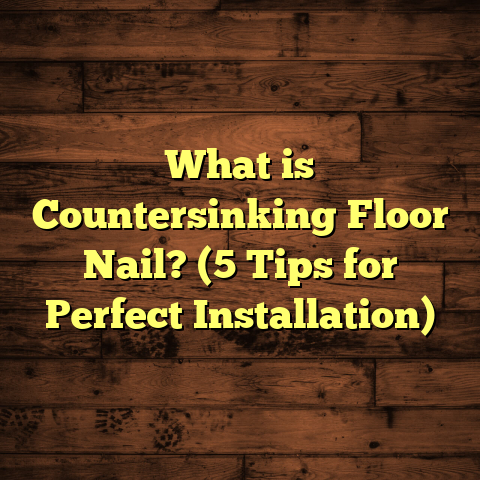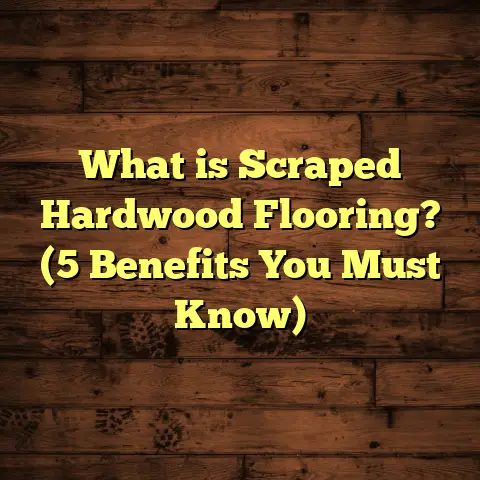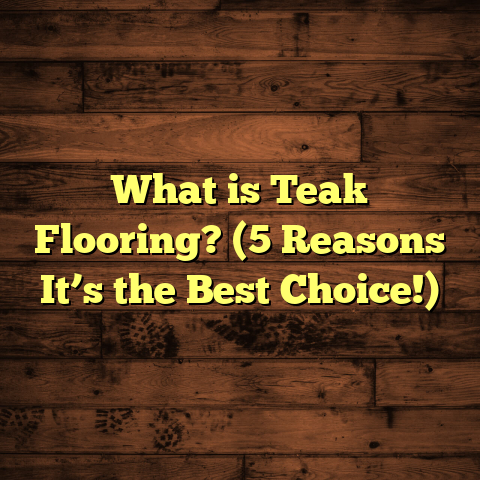What is a Chevrelle Floor? (5 Benefits You Didn’t Know!)
Have you ever heard of a Chevrelle floor and wondered what makes it different from the typical hardwood or laminate options everyone talks about? I remember the first time a client mentioned it during a home renovation project. I had only vague ideas about engineered flooring but hadn’t really explored this specific product line. That curiosity led me down a rabbit hole of research, hands-on experience, and conversations with manufacturers and installers. What I discovered blew me away—Chevrelle floors offer a unique blend of beauty, durability, and value that most people don’t realize.
If you’re thinking about upgrading your home or office flooring and want something that combines the warmth of natural wood with modern technology, stick with me. I’ll walk you through everything you need to know about Chevrelle floors—from what they are to their surprising benefits, installation tips, and real-world examples from my own work.
What is a Chevrelle Floor?
First things first: what exactly is a Chevrelle floor? At its core, Chevrelle flooring is a brand or style of engineered wood flooring. Engineered wood floors are made by bonding layers of wood together to create planks that look like traditional hardwood but are built for better performance in various environments.
Chevrelle floors feature a top layer of real hardwood veneer—often oak, maple, walnut, or other species—over multiple cross-layered plywood or high-density fiberboard (HDF) cores. The layers beneath the veneer are arranged so their wood grains run perpendicular to each other. This cross-grain construction minimizes natural wood movements caused by humidity and temperature changes.
Unlike solid hardwood floors that are milled from single planks, Chevrelle floors’ multi-layer structure offers greater dimensional stability. This means they resist warping, shrinking, and expansion better than regular wood floors. Plus, they can be installed in places where solid hardwood would struggle, like basements or over radiant heating systems.
Understanding Engineered Wood Flooring Construction
Let me explain the layers in more detail because this is where Chevrelle’s strength comes from:
- Wear Layer (Veneer): This is the visible top surface made from thin slices of premium hardwood. It provides the authentic wood look and texture.
- Core Layers: Beneath the veneer are several layers of plywood or HDF glued under pressure. Each ply’s grain runs perpendicular to the adjacent one.
- Backing Layer: The bottom layer stabilizes the plank further and prevents moisture from seeping in from below.
This design mimics the plywood concept used in construction—strong, flexible, and stable.
Why is Chevrelle Flooring Gaining Popularity?
You might wonder why this type of flooring is becoming more popular in homes and commercial spaces. For years, people have focused mainly on solid hardwood for its natural beauty. But solid hardwood has drawbacks like vulnerability to moisture and difficult installation.
Chevrelle floors offer a middle ground—they keep the look and feel of real wood but solve many problems associated with traditional hardwood floors. They’re easier to install, more affordable, and handle climate variations better.
In my experience working with clients across different regions, Chevrelle floors have become a go-to recommendation for anyone who wants quality without constant maintenance headaches.
5 Benefits of Chevrelle Flooring You Didn’t Know About
There are plenty of benefits to choosing Chevrelle flooring that even seasoned homeowners might not be aware of. Here are five that surprised me when I first started working with these floors.
1. Superior Stability and Moisture Resistance
Wood’s natural tendency to expand and contract due to humidity is one reason many people avoid hardwood in kitchens or basements. I’ve seen countless cases where solid hardwood warped after a few months just because of seasonal moisture changes.
Chevrelle floors solve this with their engineered core layers. By alternating grain directions in each plywood layer beneath the veneer, they counteract wood’s natural expansion forces. This cross-ply technique reduces swelling and shrinking by up to 50%, according to tests by the National Wood Flooring Association (NWFA).
This means you can install Chevrelle floors in environments where solid hardwood would fail—like below-grade basements or rooms with radiant heat flooring systems.
2. Faster and More Flexible Installation
Have you ever dreaded the thought of ripping up your old floor because installation seemed like a huge hassle? With Chevrelle flooring’s click-lock or tongue-and-groove systems, installation can be remarkably straightforward.
I once helped a client install over 1,200 square feet of Chevrelle flooring in just three days with minimal disruption to their daily life. The floating installation method allowed us to lay the floor over existing subfloors without nails or glue. This saves time and money on prep work.
Plus, because the planks aren’t nailed down permanently, it’s easier to replace damaged sections later without major demolition.
3. Wide Range of Styles and Finishes
Chevrelle floors come in an impressive array of wood species, colors, finishes, and textures. Thanks to the real hardwood veneer on top, you get authentic grain patterns that can be matte, glossy, hand-scraped, wire-brushed, or distressed for character.
This variety means you can find something to match nearly any interior design style—from sleek modern condos with light-colored maple to rustic farmhouses featuring aged oak tones.
One client wanted something unique for their beach house—a whitewashed oak finish with subtle knots—and we found a Chevrelle product that perfectly fit their vision.
4. Cost Savings Without Compromising Looks
Budget plays a huge role when choosing flooring. Solid hardwood can run anywhere from $8 to $15 per square foot just for materials—and that doesn’t include installation.
Chevrelle flooring typically costs 20-40% less depending on the species and finish. A recent price survey I reviewed showed average prices around $4 to $8 per square foot for quality engineered wood compared to $10+ for solid hardwood.
Considering you still get real wood on the surface plus better durability, this cost difference adds up—especially for large spaces.
5. Environmentally Friendly Choice
Sustainability is an increasing priority for many homeowners—including myself. Because Chevrelle floors use thinner slices of real wood layered over plywood cores, manufacturers can produce more planks per tree harvested compared to solid wood flooring.
Many brands also source their wood from FSC-certified forests that ensure responsible forest management. Some companies incorporate recycled materials into their core layers or use low-VOC finishes that improve indoor air quality.
Choosing Chevrelle flooring can reduce your environmental footprint without sacrificing quality or beauty.
My Personal Journey with Chevrelle Floors
I’d like to share a bit about how I came across Chevrelle flooring firsthand and what working with it has taught me over time.
A few years back, I was tasked with renovating an older home where the original hardwood had suffered water damage after flooding. The homeowners loved the look of wood but didn’t want to deal with recurring warping issues. After researching options, I suggested Chevrelle flooring because it offered natural beauty plus engineered stability.
The installation went smoothly using floating planks over a well-prepared subfloor. The homeowners were thrilled—not only did their living room look warm and inviting again, but even after six months with kids and pets running around, the floor remained flawless.
Since then, I’ve recommended Chevrelle products for numerous projects: urban apartments where sound insulation mattered; lake cottages exposed to humidity swings; commercial offices needing durable yet attractive surfaces; and more.
Detailed Installation Guide for Chevrelle Floors
Thinking about installing Chevrelle floors yourself or hiring someone else? Here’s what I’ve learned that helps make the process hassle-free:
Step 1: Acclimate Your Flooring
Wood needs time to adjust to its new environment before installation. I always advise clients to leave unopened boxes of flooring planks in the installation area for at least 48 hours. This helps balance moisture levels in the wood with room conditions and reduces post-installation movement.
Step 2: Prepare the Subfloor
The subfloor should be clean, dry, level within 3/16 inch over 10 feet, and free from debris or protruding nails. Unevenness can cause creaks or damage over time.
For concrete subfloors especially, use a moisture barrier underlayment approved for engineered wood installations.
Step 3: Choose Your Installation Method
Chevrelle floors typically support several installation methods:
- Floating (most common): Planks lock together over underlayment without glue or nails.
- Glue-down: Adhesive applied directly to subfloor.
- Nail-down/Staple-down: Used mainly when installing over wooden subfloors.
Floating installations are easiest for DIYers or those wanting quick renovations.
Step 4: Install Underlayment
Underlayment reduces noise transmission, adds comfort underfoot, and provides additional moisture protection. It’s essential for floating installations.
Step 5: Leave Expansion Gaps
Wood expands slightly with temperature changes. Leave 1/4 inch gaps along walls or fixed objects so the floor can “breathe” and avoid buckling.
Step 6: Maintain Regularly
Keep your floor looking great by sweeping or vacuuming weekly and wiping up spills promptly. Avoid harsh chemicals—use cleaners recommended for engineered wood surfaces.
Case Studies: Real-Life Success Stories
Case Study #1: Urban Condo Renovation
A young couple living in a downtown condo wanted an elegant floor that could handle high foot traffic from pets without looking cheap. We installed hand-scraped oak Chevrelle planks with a matte finish over radiant heating pipes.
After one year, they reported zero issues with warping despite winter humidity swings. The floor retained its charm while requiring minimal upkeep.
Case Study #2: Lakeside Vacation Home
A family needed flooring that could tolerate moisture fluctuations near a lake while maintaining a cozy cabin feeling. We chose wire-brushed walnut Chevrelle floors with enhanced moisture resistance coating.
The floors performed exceptionally well through humid summers and snowy winters without swelling or cracking.
How Does Chevrelle Compare to Other Flooring Options?
You might be wondering how it stacks up against laminate, vinyl plank, bamboo, or solid hardwood:
| Flooring Type | Durability | Water Resistance | Cost (per sq ft) | Maintenance | Appearance |
|---|---|---|---|---|---|
| Chevrelle (Engineered Wood) | High | Moderate | $4 – $8 | Moderate | Natural wood veneer |
| Solid Hardwood | High | Low | $8 – $15 | Moderate | Authentic wood |
| Laminate | Moderate | Moderate | $1 – $4 | Low | Wood-like (printed) |
| Vinyl Plank | High | High | $2 – $7 | Low | Varied (wood-look) |
| Bamboo | Moderate | Low-Moderate | $3 – $8 | Moderate | Natural grass fiber |
Chevrelle offers a sweet spot between natural aesthetics and practical performance at a reasonable price point compared to solid hardwood.
Addressing Common Concerns About Chevrelle Floors
Can I refinish Chevrelle flooring?
Yes! Depending on veneer thickness (usually 2-6 mm), you can sand and refinish engineered wood once or twice during its lifespan—unlike laminate which cannot be refinished at all.
Is it suitable for underfloor heating?
Absolutely! Engineered floors like Chevrelle are less prone to heat-induced movement than solid hardwoods, making them ideal for radiant heating systems if installed according to manufacturer guidelines.
How do I clean these floors properly?
Use pH-neutral cleaners designed for engineered wood. Avoid excessive water during mopping as standing moisture can damage layers beneath the veneer over time.
Final Thoughts on Choosing Your Flooring
When I help people decide on flooring options, I always encourage them to consider lifestyle factors alongside budget and style preferences. Floors are an investment that affect daily comfort and resale value.
If you want warmth, authenticity, stability against moisture changes, easy installation, and eco-friendliness—all wrapped into one—Chevrelle flooring deserves serious thought.
Feel free to ask me about trusted suppliers or brands offering high-quality Chevrelle products matching your taste and requirements. And if you want advice on maintaining your new floor through different seasons or heavy use scenarios, just reach out!
Would you like me to provide detailed brand comparisons or installation videos next? Or maybe suggestions on pairing Chevrelle floors with wall colors and furniture styles? Let me know!





